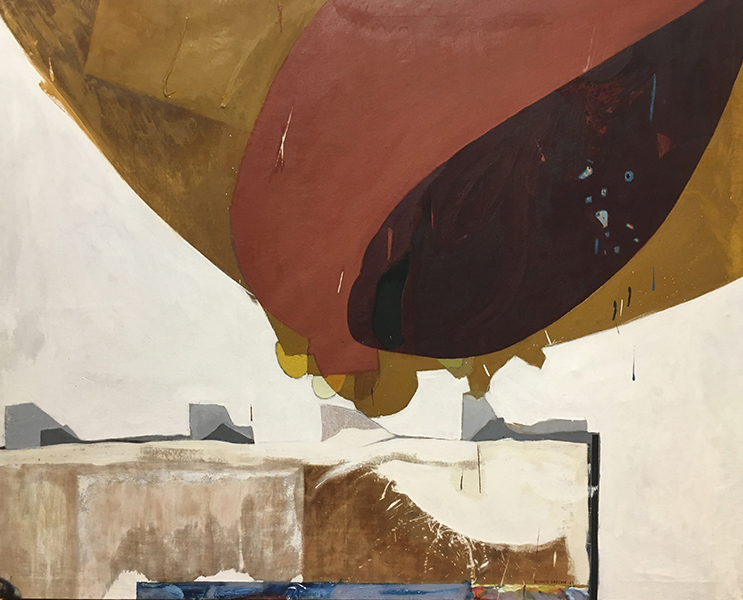Dennis Burton
Dennis Burton (1933-2013): Artist Biography
Artist, educator, musician, Dennis Burton, played an integral role in a very exciting period of Canadian cultural history– Toronto’s vibrant and expanding Art Scene during the 50’s, 60’s, 70’s and 80’s. Embracing the ideas and freedom of visual and painterly expression, Burton was part of “a group of eclectic and innovative Toronto artists, whose rebellious nature and exuberance was expressed in making art that challenged current paradigms. The idealism of the sixties filled the young people of North America with hope, and we felt that we, the artists, could actually “change the world.” DPugen in conversation with Nobuo Kubota. In those early years while working for CBC Burton created the iconic and award winning skater animation that was used for so many years to introduce Canadians to “Hockey Night in Canada”
The Isaacs Gallery, Toronto’s purveyor of Avant-garde art, exhibited Burton’s work since it’s inception with along with artists Michael Snow, Joyce Wieland, Graham Coughtry, Nobuo Kubota, Gordon Rayner, Robert Markle Robert Hedrick, William Ronald, John Meredith, Jack Chambers, Richard Gorman, John MacGregor, many of whom were Burton’s close friends
Viewing a Burton exhibition at the Isaacs Gallery, the Actor Charles Laughton was drawn to the originality of Burton’s abstract expressionist paintings and facilitated exhibitions of his work in California. Burton’s lifelong love of improvisational jazz was expressed through his saxophone, and The Artists Jazz Band, which he with friends Graham Coughtry, Nobuo Kubota, Gordon Rayner, Robert Markle. founded
In the ‘60’s Burton began to extol the female form as he painted a series of figurative paintings of women in undergarments. His major exhibition of that work roused the ire of John Diefenbaker who denounced Dennis Burton in the House of commons coining the term “garter belt-maniac” creating Burton’s infamous reputation.
Born in Lethbridge, Alberta in 1933, Dennis won a scholarship to Pickering College, later attending OCA, and working with artists Fred Hagan and Jock Macdonald who were strong influences. He graduating with honours in 1956, and later studied with Rico Lebrun at the University of Southern California (1955), and Ben Shahn at the Skowhegan School of Painting and Sculpture, Maine (1959). Burton’s passion for painting, his dissatisfaction with the status quo of art education and his dedication to contemporary art practices lead to his involvement in alternative art education. In 1965 with Robert Hedrick, Burton founded the New School of Art Toronto’s first alternative post-secondary art school, under the auspices of The Three Schools.
In 1970 he was invited to chair the Drawing and Painting department of the Ontario college of Art (OCAD University) just before the tumult of the Roy Ascot years. Here, he created a bit of a revolution, first, by bringing in all his colleagues as new faculty, adding their vitality and contemporary thought to the DRPT program, and then refusing tenure he resigned, returning to the New School of Art, as its’ Director (1971-1977).
In 1977, Burton and artist Diane Pugen (to whom he was married for 20 years), with colleagues Graham Coughtry, Gordon Rayner, Robert Markle and. Robert Hedrick, Ross Mendes, David Bolduc, Paul Sloggett, Ken Lyewood, Zibigniew Blazeje and Joan Van Damme founded Art’s Sake Inc, The Institute for Visual Art, the first Independent alternative totally artist run post secondary art school.
In 1979 Burton joined the faculty of Emily Carr College of Art and Design in Vancouver and taught there for 20 years his retirement
Artist, educator, wordsmith, innovator and mentor experimentation and risk taking permeated his work. His later abstractions play with text and language in eclectic ways. Burton’s ever inquisitive mind, and his creative and eccentric manner of configuring facts to fulfill his insatiable pursuit of knowledge, along with his need to communicate all of that, filled much of his waking hours and permeated his teaching enriching the lives of his students and many of those he touched.
Permanent Collections:
Art Gallery of Ontario, Toronto
The Canada Council Art Bank Collection
The Hirshhorn Museum, Washington
Glenbow Museum, Calgary
Los Angeles County Museum
Montreal Museum of Fine Arts
National Gallery of Canada, Ottawa
Robert McLaughlin Gallery, Oshawa
Smithsonian Institution, Washington
Southern Alberta Art Gallery, Lethbridge
Vancouver Art Gallery
Walker Art Center, Minneapolis
Artist Specialization: Throughout his career, Burton created abstractions that might involve using different creative strategies involving language, colour and form. He initially was influenced by American Abstract Expressionist artists such as Robert Motherwell, Jack Twarkov and Willem de Kooning. In the late 1950s and early 1960s he produced sculpture by welding scrap metal and found materials together. Art historian and curator Joan Murray declared that “his paintings, figurative, abstract or calligraphic, are full of dashing energy.”


